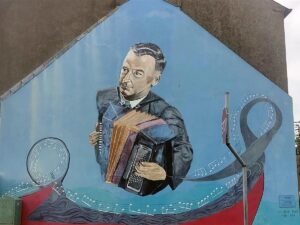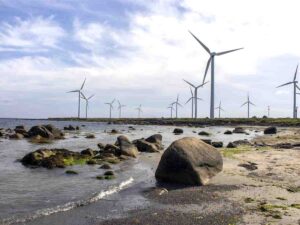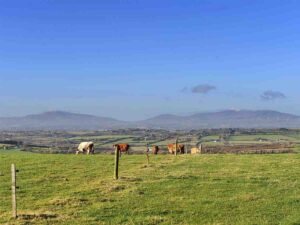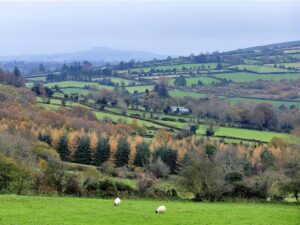An ecosystem includes all of the living things (plants, animals and organisms) in a given area, interacting with each other, and also with their non-living environments (weather, earth, sun, soil, climate, atmosphere).
Ireland is lucky enough to have rich biodiversity across its land, and the more biodiverse an ecosystem is, the better for everyone. Ireland’s biodiversity stems in large part from the exceptional diversity of its geology – the bedrock that underlies the landscape. This has shaped our landscape with its mountains, rivers and very varied coastline. As a result of this variety, we have an exceptional diversity of habitats, given the size of the island. The second factor influencing our diversity is our mild, moist climate which allows unusual combinations of plants and animals to survive.
major threat to biodiversity is extinction. Any type of plant or animal can die out, meaning that in its absence, all of the ecosystems that it inhabited must change or risk dying out themselves. Either option will have a profound effect on the ecosystem and will go on to have a profound effect on humans’ lifestyles as well. Protecting biodiversity is fairly easy. The world works quite well the way it was designed, so all humans need to do is let it function! Do your part to reduce, reuse and recycle whenever possible and enjoy the rich varieties of plants, animals and habitats all around you.
As our network of trails range from coastal to woodland, we are fortunate to have a great variety of biodiversity. In developing this biodiversity page, it is our intention, on an ongoing basis, to gather information on the range of biodiversity which exists on the trails in our network. This page illustrates the range of biodiversity available on our network of trails as a whole. If you would like to see the biodiversity on a particular trail, please visit the individual trail’s page.
We would also like to engage with those who walk our trails. We would ask walkers to assist in developing this bank of information by getting in touch if you see something unusual or indeed if you have any biodiversity related observations: [email protected]
We would like to acknowledge support and funding received under the Agenda 21 scheme which enabled us to compile the biodiversity information and photographs contained on this page and individual trail pages.
This is only a snapshot of some of the flora and fauna you may spot on a walk through the Wexford landscape. Please bear with us while we build a comprehensive database of the rich and varied wildlife found on the many diverse trails that are part of Wexford Walking Trail.
| Askamore | Generic native flora / fauna | |
| Bunclody – Coolmeelagh | Generic native flora / fauna | All kinds of native wildlife, such as Sika deer, Irish hare, fox, badger, Peregrine falcon, hen harrier raven |
| Bunclody – Kilbranish | Sika Deer | |
| Carrickbyrne | Generic native flora / fauna | The trees are mainly a coniferous international gathering, with representatives from Europe and North America including Douglas fir from
Vancouver, Japanese larch from the east and native Scots pine. You will also find oak, beech, ash, rowan, and Spanish chestnut. Laurel, bramble and heather form the main ground cover of the wood. On the trail through the forest, keep an eye out for foxes, rabbits, hares or listen out for a blackbird, thrush and jay. |
| Courtown | Lords and Ladies – arum maculatum; wild garlic – allium ursinum | A majestic Cedar of Lebanon on the river bank viewed from the Top Walk
A yew tree planted in the 1870s, felled many years ago, continues to grow adjacent to the River Walk |
| Enniscorthy | Otters | |
| Kelly’s Wood | The wood is now managed by Coillte where Oaklands is a good example of Wet woodlands is important for the less conspicuous elements of biodiversity, i.e. insects and lichens. In wet areas, depending on factors such as degree of water logging and soil pH, wet-loving trees such as willows, birch and alder.
It is a good example of acid oak woods, i.e. oak-dominated woodland on acidic soils, Downy birch is often abundant in the canopy with oak. There is often an understorey of holly, with some rowan. The ground flora typically includes species such as woodrush, bilberry and ferns. The ground flora here may include primrose, wood anemone and bluebell.
|
|
| Kilanerin / Curragh Woods | Buzzards
Red Kites |
|
| Ferns Village | Alder tree – fearnóg in Irish – giving its name to the village | Village walk incorporating local river |
| Forth Mountain | Fly Agaric Mushrooms
Cuckoo Heather Fraughans Lichen |
|
| Kilmore Quay / Ballyteige Burrow | Little Terns – Ireland’s smallest / rarest species – nest on beach at western end
Meadow Pipits Wrens Stonechats Linnets Wheatears & Reed Buntings pass through in spring Skylark – spring / early summer – becoming scarce Migratory butterflies: Red Admiral Painted Lady Clouded Yellow – occasionally Hummingbird Hawk Moth – day flyer Resident: Dark Green Fritillaries – important Common Blues Day Flying Cinnabar Moth Invertebrates: Turf Ant – found in very few places in Ireland Rare Woodlice, Snails, Wasps and two of Ireland’s rarest bee species – Great Yellow Bumble Bee and the Shrill Carder Bee |
|
| Lacken Hill | Dipper – found in The Maudlins
Otter – The Maudlins & Lackin Buzzard – Lacken Stoat |
|
| Oulart | Generic native flora / fauna | |
| Raven Wood | Natterjack Toad
Round Leaved Wintergreen |
|
| Rosslare Harbour | Seals
Coastal grasses Seabirds Seaweeds |
|
| Tara Hill | ||
| Tintern | Bat | Fine Beech, Oak, and Chestnut trees as well as Kingfishers, Egrets, Buzzards, Red Squirrels, Stoats, and seven types of Bat |





